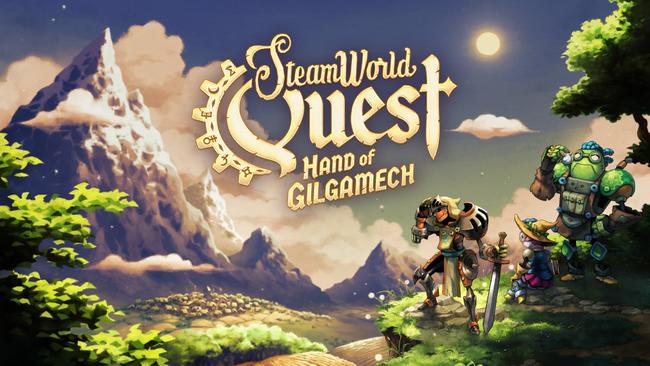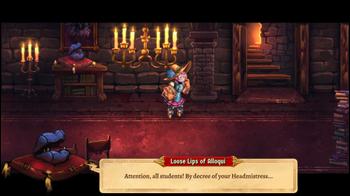
SteamWorld Quest: Hand of Gilgamech Review
Charming and endearing all-around, the developers over at Image & Form have carved out an intriguing little series with SteamWorld. To those unfamiliar, these games revolve around cute steampunk robots that tend to exhibit a life of their own outside their intended programming. I found the SteamWorld Dig games enjoyable, and SteamWorld Heist hooked me with its unique blend of XCOM-type battles from a 2D side-scroller angle. Image & Form has a knack for meshing together unlikely genres in intuitive ways, so when I heard they were tackling a more traditional RPG, my ears perked up. SteamWorld Quest: Hand of Gilgamech is another great entry and one of the most creative RPGs I’ve seen in a while.

Its main hook is simple enough on paper; a turn-based RPG caught in the middle of a deck-builder card game. The concept itself has been done before. In fact, I consider SteamWorld Quest an odd amalgamation between Slay the Spire and Fate/Grand Order, but it splits the difference by borrowing enough elements of both to mold its own unique take in creative ways.
Laying out how combat works can be a bit thick, so bear with me. Battles have a party of three face off against foes you bump into as you’re walking around. You can shave a little HP off if you hit them before engaging. Be warned, the hitbox on your swing out in the field feels unreliable. Since your character is jogging along in a 2.5D space, it can be quite finicky determining if you’re in the right lane with an enemy.
Each party member can equip up to eight cards so the standard deck size will always be 24. At the beginning, up to six cards can be drawn at once and only three can be played in a turn. Players can redraw any card from their hand twice to somewhat mitigate unlucky draws. Different modifiers and card effects can fudge these values later in the game.
Every character will have their cards color-coded. Playing three cards of the same color will activate an extra card and depending on the weapon equipped, it could be a powerful attack or a handy support skill.
Risk versus reward comes in the form of building up and spending your card ability points. Not all cards can be freely played. Basic attack cards and other weaker skills charge this shared party-wide “mana bar” so-to-speak. As you accrue more powerful spells and skills, the cost needed to play them increases. It’s quite simple to grasp really.
I was worried for the slow flow of the game at first, even with the option to speed things up toggled on. The first three characters are cool and all, but their playstyles early on didn’t quite compliment each other in a satisfying way. SteamWorld Quest’s first few hours are disappointingly slow and the game drags its feet for a bit. It wasn’t until I got the fourth party member that things clicked with me and I received an epiphany of how I wanted to strategize my deck for the rest of the game.
Oddly enough, SteamWorld Quest’s greatest strength may also be one of its biggest downfalls. There’s an absolute plethora of card combinations and strategies under the hood. It encourages experimentation and is pretty transparent on how each character’s card set fits into a distinct role, yet it makes no attempt to guide or clue-in players who’re less keen on that genre. A video demonstration of how a card could be utilized could’ve gone a long way for less experienced players.
The interface to construct a deck is initially manageable, but as more cards are collected and crafted, that pool becomes large and unwieldy to navigate. Characters eventually have multiple pages of cards to flip through making it difficult to find a specific one immediately.
Ultimately what’ll make or break SteamWorld Quest for players is their willingness to tinker around with a deck that can handle situations in a timely manner. Later into SteamWorld Quest, the HP values on foes just spike across the board. Battles certainly become more methodical at the cost of having every encounter feeling like a war of attrition.
I also find that the game has some repetitive mission design. It constantly throws locked doors and devices as its main platform of puzzle solving with little deviance. Luckily, SteamWorld Quest does a great job varying up its environments though. I never felt like I was staring at one type of scenery for too long.
Despite these minor downfalls, I believe that SteamWorld Quest is still a fun game to play if you’re willing to learn the finesse of its dynamics. It’s flexible enough that a variety of team synergies will generally work for any type of RPG player. There are a lot of fun domino-effect moments that click once you realize how certain cards can work together; there are even cards that are enhanced if played after another character’s card leading to some fun combos to maximize damage potential.
If you’re new to the SteamWorld series and concerned about the story, worry not - all of their games are standalone. There’s certainly deeper lore that loosely binds them, but it’s certainly not necessary to understanding the narrative.
That said, I wasn’t too fond of SteamWorld Quest’s overall plot, but I liked its characters a lot. Without giving away too much, it takes place inside a storybook that follows the adventure of Armilly, Copernica, and Galleo in search of the reason why their village was attacked. I found the tale too simplistic and predictable; the main antagonist’s intentions and motivations are a particular sore spot that doesn’t do it any favors.
Setting these weaknesses aside, the game has some astounding character work behind most of its main cast. Copernica and the other members that join up have compelling character arcs that had me wishing SteamWorld Quest gave more of a spotlight and attention to. There’s a bundle of potential that the game only scratched the surface of. Those moments are too backloaded as well; if the game sprinkled these more early on, it probably would’ve done wonders for its uneven narrative flow.
As with all SteamWorld games, its aesthetic sense is superb. Each of its robotic character designs are filled with surprising twists in how steampunk could be perceived. Having all of its cards actually be punched cards is also a very clever idea that feeds into its world building naturally. The amount of expressiveness in its card art is truly something special.
I finished it just shy of 13 hours; it especially plays to the Switch’s portable strengths with bite-sized chapters. It felt like a game that would support touchscreen control, but sadly it does not. It does have some slowdown issues when there are too many visual effects popping off on the screen. This was most noticeable in the final battles.
SteamWorld Quest: Hand of Gilgamech is a delightful RPG experience. Though there are problems around its edges with prolonged battles and a weak overall narrative, its ability to maintain a deck-building card game inside a RPG in inventive ways continually is nothing short of awesome. Once it clicks with you, it’s hard to not stop theorycrafting, experimenting, and optimizing your deck.


